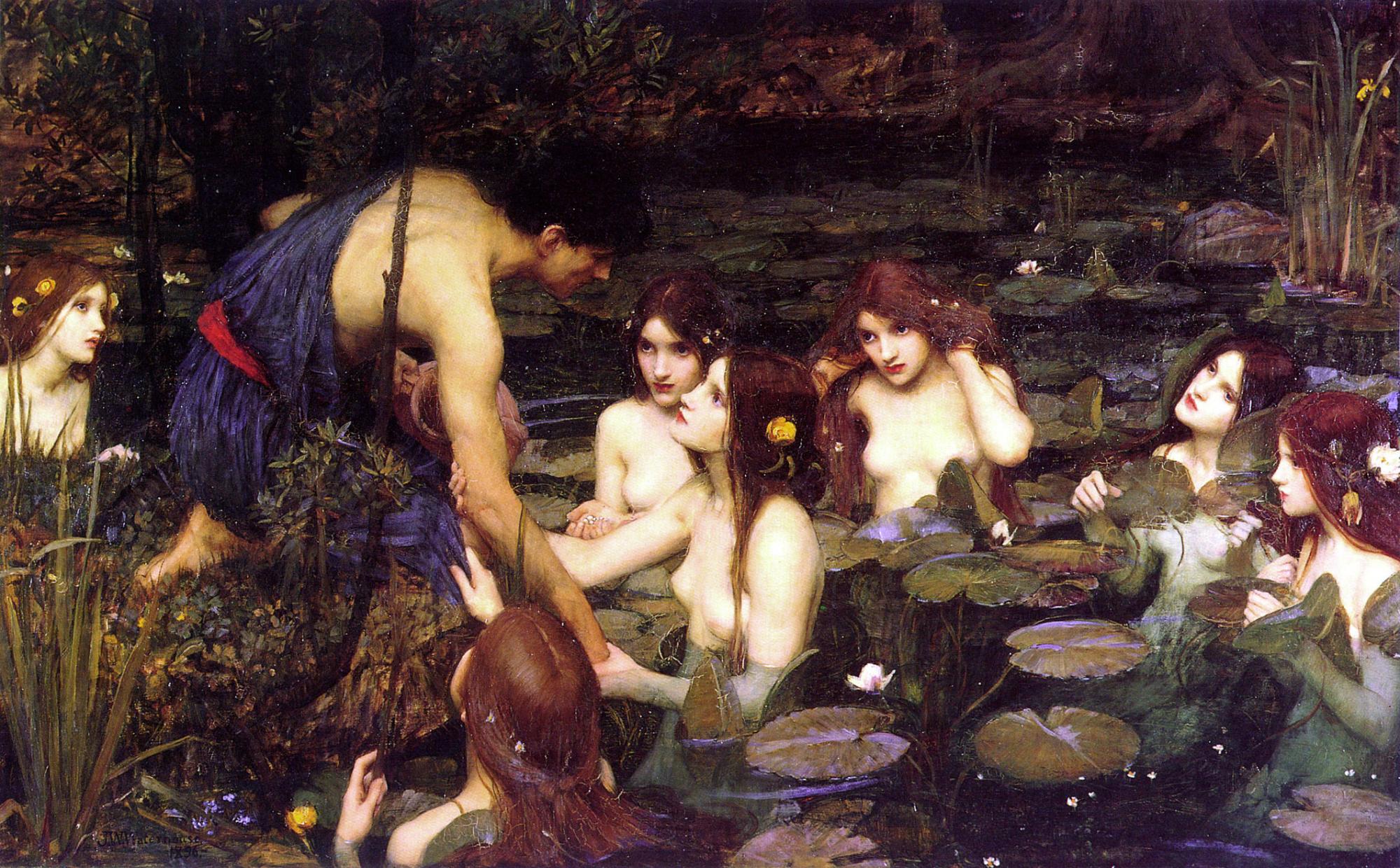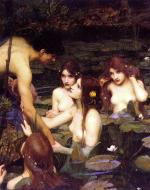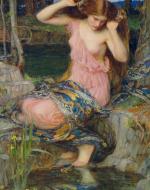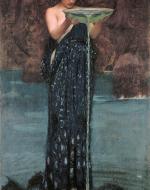Created by Alexander Cesani on Fri, 02/16/2024 - 16:17
Description:
Display Explanation:
This exhibition takes place in the greenhouse of a botanical garden during the early afternoon on a day full of sunshine. There is a path of decomposed granite that leads you through lush foliage to large glass double doors of a large glass building. Entering the building, you feel a humid warmth from the tropical plants that surround you. There are large birds of paradise that share space with large ferns and monsteras. Pothos hang from the exposed metal rafters that span between brick pillars. Sunlight streams in from above creating sunbeams as it finds the spaces between the leaves. The sounds of trickling water reach your ears. There is a koi pond that winds out diagonally across the greenhouse mimicking a stream and keeps the plants watered. A flagstone path is what guides you through the exhibit and keeps you from disturbing the soil of the garden or falling into the water.
As you follow the path, you are led over the pond by a wood bridge to a courtyard that is half surrounded by a wall made of plants in planter boxes and half surrounded by the pond. There are other visitors to the exhibit congregating in this space. Found on the edge of the courtyard, where the stream meets the planters, in a gilded gold frame on a wood easel is the first work in this exhibit, John William Waterhouse’s 1896 work, Hylas and the Nymphs. Some of the other visitors are looking at the work, but other visitors are looking at the surrounding flora, not giving Hylas direct attention.
After you have taken the time to appreciate Hylas and the Nymphs, you look for signs for where to go next. There is a break in the wall of planters where the flagstone path subtly invites you to continue exploring the exhibit. You duck under the broad leaf of an elephant’s ear while following the path before stopping with the stream directly in front of you. On the other side of the stream in a gilded gold frame and sitting on a wooden easel, is Lamia, the 1902 work of John William Waterhouse. While you stand square to the painting before you, there are ferns that grow to just above waist height, and there are similar ferns that are potted resting just at the base of the easel. Between you and the other side of the stream, the pothos reach down from overhead.
There is a marked difference in the feeling of the exhibit. After having glimpsed Lamia, to your right, along the wall, the flagstone path and the stream turn and run parallel. Your path now takes you into a stone hallway. The sunlight from the greenhouse can only follow you in so far. You have to trust your feet as the path before you becomes less visible and your eyes adjust. The water is phosphorescent and glows. It leads on one side of the flagstones. The glowing water collects in a large room at the end of this corridor, and you arrive on an island in the center of the room. In a silver frame, illuminated by 2 spotlights in the floor and suspended from wires that extend to a ceiling that you can’t see, is Circe Invidiosa ,the 1892 work of John William Waterhouse.
Installation Note:
This installation has a heavy focus on water. In literature and in art, water is often used to show the duality of a subject. Water is life-sustaining. It soothes. It purifies. Water draws people closer while also being capable of hiding danger just beneath the surface. Water can drown you; it can play host to predators; it can carry poison. This same duality can be found in the femme fatale. The femme fatale is an archetype of a woman who uses her sexuality to lure a man to his doom. The subjects of this installation's works are femme fatales of Greek mythology as depicted by John William Waterhouse. With one hand, they would invite you in, and with the other, they would plot out your demise.
The first image in this installation is Hylas and the Nymphs, 1896. The image depicts Hylas at the edge of a pool. In the pool are several beautiful, naked women. These women are river nymphs. The mythology of this piece is that the nymphs were attracted to Hylas. Hylas had fallen prey to the seduction of the nymphs. He was drawn to the water’s edge by their beauty and sexuality. The nymphs then pull Hylas into the pool, so deep that not even Hercules could rescue him. The nymphs’ seduction and feminine wiles spelled doom for Hylas, forever their prisoner.
The second image in this installation is Lamia, 1902. The image depicts Lamia grooming herself in the reflection of a pond. Her breast is exposed, though she makes no effort to cover it up. Upon her lap, there appears to be a silk scarf. The scarf is actually the skin of a giant serpent. The mythology of Lamia is a tragedy. Lamia was a beautiful woman with whom Zeus took a liking. Zeus came down from Olympus and had an affair with Lamia. Once Hera discovered the infidelity, she cursed Lamia to be a shapeshifter. Lamia is cursed with a lonely existence. She lures young men to her with her beauty in her human form, and when the man is vulnerable, she devours them as a giant serpent.
The final image in the installation is Circe Invidiosa, 1892. The image depicts a dark-haired woman standing on the surface of the water of a pool with an intense look on her face. Her dress covers only one breast and is made to expose her hip. It is the kind of dress that one might wear as part of a seduction. This woman is Circe. Most will know Circe from Homer’s “The Odyssey” in which she is a seductress who turns Odysseus’ men into pigs to then take Odysseus as a lover. The mythology that this image refers to Circe’s failed seduction of Glaucus, a man who asked her to make Scylla, a beautiful woman, love him. Circe falls in love with Glaucus and tries to seduce him. He rejects her, and in her jealousy she poisons Scylla’s bathing pool, as depicted in the painting, dooming Scylla to a monstrous existence.
These works bring into perspective the powers and limitations of seduction. With Hylas, the nymphs took him entirely and showed limitations only in that they were confined to the waters in which they inhabited. Lamia has greater complications. Hers is a cursed existence. No matter the extent of her desires, her sexuality can never be her own. Whether she chooses to or not she will devour those she seduces as a monster. Finally, Circe is depicted as having failed in her seduction. She had found an absolute limit of the power of her seduction and ultimately found power in her knowledge of magic and cursing of Scylla.
Waterhouse, John William. Lamia 2. 1909. https://en.m.wikipedia.org/wiki/File:Lamia_Waterhouse.jpg. Accessed 16 Feb 2024.
Waterhouse, John William. A Naiad, or Hylas with a Nymph. 1893. https://en.wikipedia.org/wiki/John_William_Waterhouse#/media/File:A_Naiad_or_Hylas_with_a_Nymph_by_John_William_Waterhouse_(1893).jpg. Accessed 16 Feb 2024.
Waterhouse, John William. Circe Invidiosa. 1892. https://en.wikipedia.org/wiki/Circe_Invidiosa#/media/File:Circe_Invidiosa_-_John_William_Waterhouse.jpg. Accessed 16 Feb 2024.
Copyright:
Associated Place(s)
Featured in Exhibit:
Artist:
- John William Waterhouse




